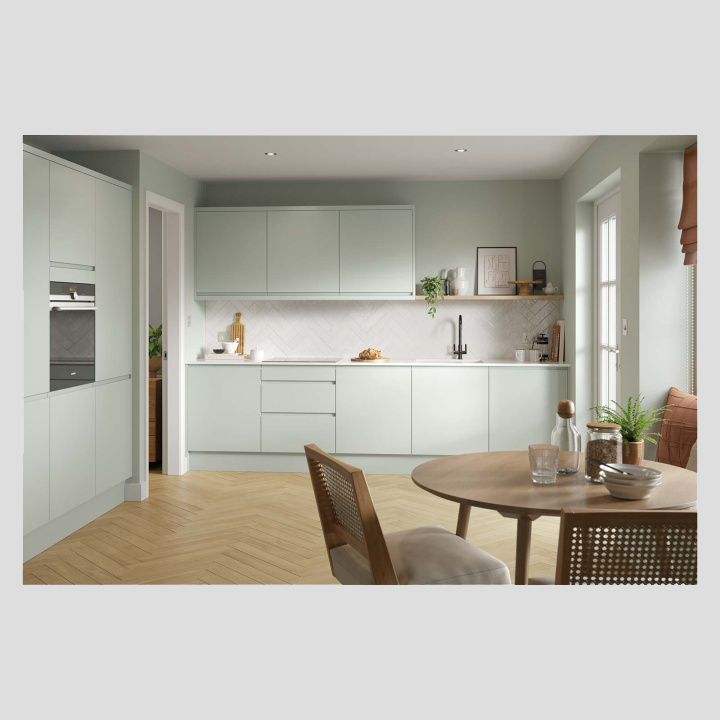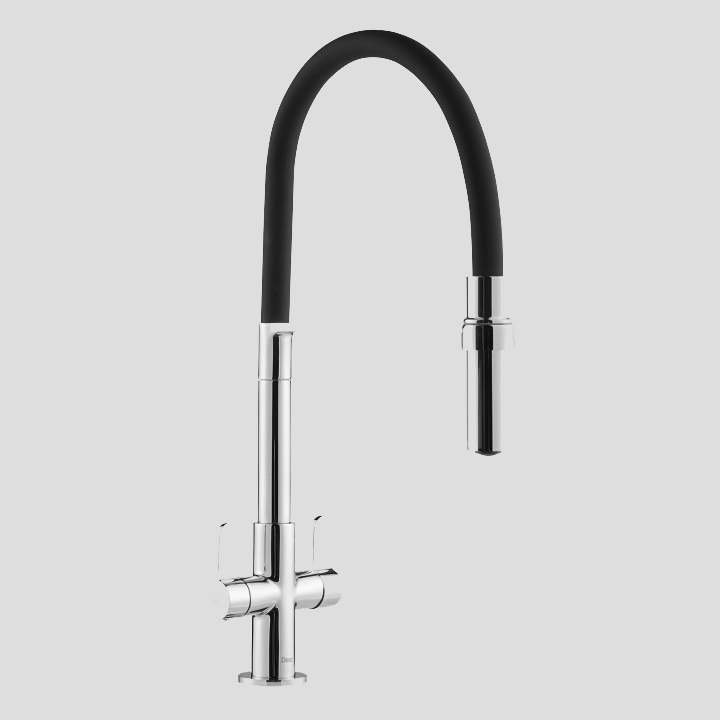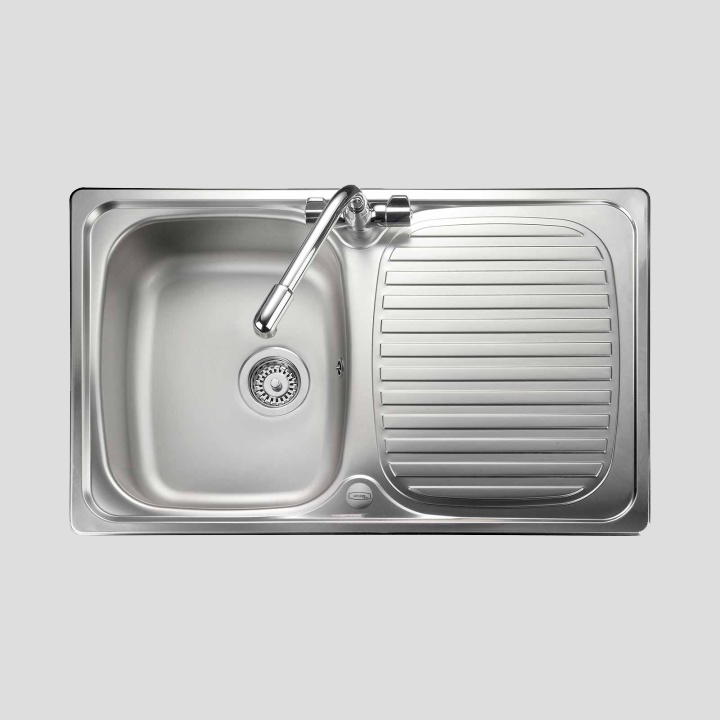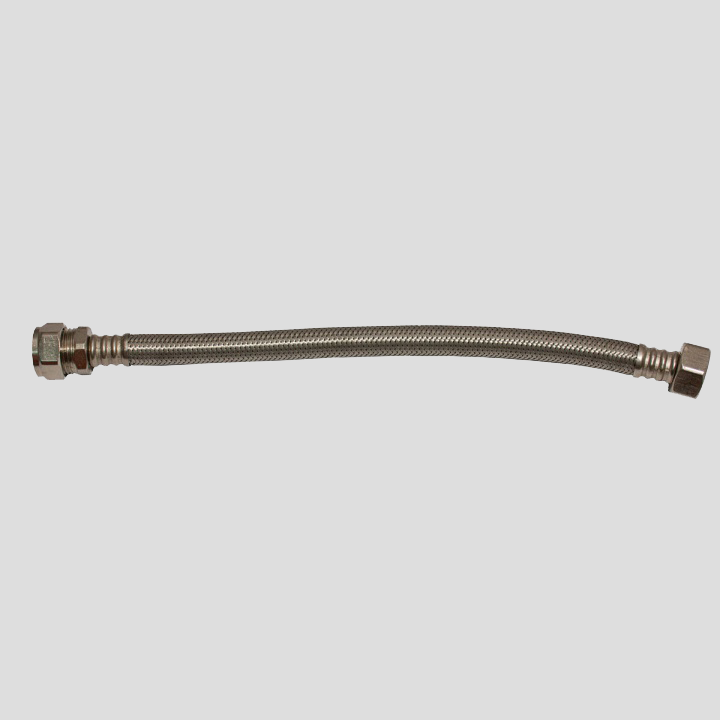Whether you’re working on a brand-new kitchen for a customer, completing a renovation, or just simply replacing a few broken or outdated fixtures, choosing the right kitchen taps is always an essential part of the project. Your customers will have spent a lot of time thinking about their kitchen design – like the flooring, paint colour, sink, cabinets and other appliances – but sometimes forget about something they’ll use multiple times a day: the tap!
To help bring your customers’ dream kitchen to life we have many other helpful blogs to browse through, such as what flooring is best for a kitchen and how to install flat pack kitchens.
So, what are the best kitchen taps? It depends on a lot of factors, including your customer’s overall kitchen design and what the tap will mainly be used for. You’ll have certain limitations that you need to work around, such as your customer’s budget, the water pressure system of the home, and the sink configuration. After that, it’s all about the style and functionality your customer prefers. Do they drink a lot of hot drinks, and would they benefit from an instant hot water tap? Do they like the idea of a pull-out hose to easily wash dishes? Is there overall kitchen design contemporary or traditional? In this blog, we’ll outline all the things you need to consider when browsing types of kitchen taps and we’re sure you’ll be able to find the best kitchen taps for the job.
What do you need to consider when buying kitchen taps?
Water pressure
Your customers’ kitchen taps will be connected to the home’s hot and cold water supply. When the tap is turned on, a valve moves upwards to allow the water to flow through the spout from the water chamber. When the tap is turned off, the valve closes.
You’ll need to know the home’s water pressure before deciding the type of kitchen tap needed. Whatever water pressure there is in the house, that’s how quickly the water will come out of the taps (unless you install a pressure booster).
If you’re wondering how to check water pressure in a home, we’ve got you covered. A high-pressure water system will feature either a combi boiler or an unvented system (with just hot water storage) whereas a low-pressure system will have a gravity-fed system (i.e. a cold-water storage in the loft and a hot water cylinder in the airing cupboard).
There are two handy ways to check the water pressure from taps:
- Place a 1-2 litre jug under a tap and turn the tap on, timing for 6 seconds. If the jug takes longer than 6 seconds to fill up, it’s a low-pressure system.
- Place a jug under a tap and turn it on, timing for 6 seconds, then turn the tap off. Multiply the number of litres of water in the jug by 10 to get the property’s flow rate in litres per minute. If the number is less than 10 litres per minute, it’s a low-pressure system.
If you’re working in a home with a low-pressure water system, you’ll need to buy taps that are suitable, or the flow will be too weak.
Water type
Depending on the area, the water in a property will be hard or soft. Hard water in a property can cause a build-up of limescale in pipes and appliances like kettles and coffee machines. If the home you’re working on is in an area with hard water, it might be a good idea to install a water filter tap which contributes to reducing limescale build-up and can make the water taste better.
Sink configuration
If you’re installing a brand-new sink, you can choose the configuration your customer wants, but if you’re installing new taps into an existing kitchen sink, you’ll be limited by the sink’s configuration. A sink can come with one, two, or no tap holes, and this will determine the best tap for the kitchen sink. For example, one-hole sinks will need monobloc mixer taps and a two-hole sink will need pillar taps or a deck-mounted mixer tap – and for a sink with no holes, the taps will need to be installed into the worktop.
You’ll also need to consider the space available above the kitchen sink. Is there a shelf in the way that might block a large mixer tap with a tall spout?
Budget / price
You’ll need to consider your customer’s overall budget when deciding on the best kitchen taps for them. A smaller budget will be able to accommodate basic features, but if your customer wants additional features such as a water filter, instant hot water, or a pull-out hose, the price is sure to increase.
Cleaning and maintenance
Different types of kitchen taps will require different levels of cleaning. Sleek, simple tap designs will be easier and quicker to clean than those with multiple parts, levers and ornate handles. Encourage your customers to clean the taps off with a soft cloth after every use and clean the tap once a week with a mild cleanser – they can also use a limescale remover weekly to remove build-up.
Kitchen style and design
A tap’s style is equally as important as its function. Your customers will have picked out their kitchen cabinets, worktops and appliances as well as flooring, and it’s important to choose the right taps to add the perfect finishing touch. A chrome finish is the most popular choice for kitchen taps as it suits any design and has a great shine when cleaned, but taps are available in many designs, colours and finishes with different spout and handle options. Traditional brass pillar taps might be more suited to a traditional, rustic kitchen while a more modern kitchen design might benefit from a more contemporary design such as black matt kitchen taps.
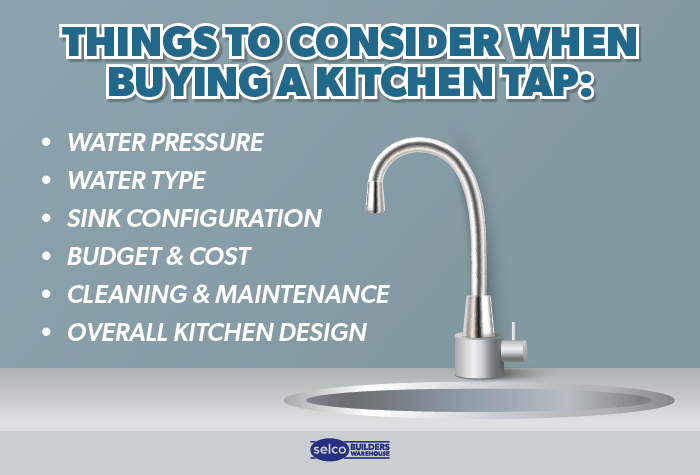
What are the different types of taps for kitchen sinks?
Pillar taps
Pillar taps are pairs of taps that feature one tap for hot water and one tap for cold water that are operated separately via a lever or handle on each tap.
Pillar taps can have many benefits in the kitchen including the fact they’re usually a little cheaper and easier to install than mixer taps. If your customer has a kitchen with a more traditional design, separate hot and cold taps might be more suited to the retro style. Pillar taps are also commonly used in utility sinks and where the hot water pressure is so low that it can’t be mixed with the cold mains water pressure.
One drawback of separate hot and cold taps is that you’re unable to control the temperature of the hot water so there’s a possible risk of scalding which can be a problem if you have small children. You could fill up the kitchen bowl with a mixture of hot and cold water to get water to the ideal temperature.
Mixer taps
There are multiple types of mixer taps for you to choose from to suit your customers. With a functional and modern design, kitchen mixer taps are a popular choice in the UK. Mixer tap styles include monobloc, deck-mounted and single lever.
Monobloc mixer taps
Monobloc mixer taps draw the hot and cold water through one neck and spout and are suitable for sinks with one tap hole. Mono mixer taps come in both single-lever and twin-lever options and allow better control of the water temperature as it flows through the tap.
Deck-mounted mixer taps
Deck-mounted mixer taps use two tap holes but have only one spout – the hot and cold sides of the tap are joined together in the middle where the water mixes to flow through the spout. The hot and cold water supplies are controlled separately with twin levers or handles.
Single-lever mixer taps
Single-lever mixer taps allow the combined flow of hot and cold water through one spout which is controlled by one lever. Single-lever taps provide excellent control over the flow of water and its temperature, with a simple and minimal design.
Pull-out kitchen taps
Some mixer taps have a hose/spout attachment that can be pulled out to reach hard-to-reach areas all around the sink. Pull-out kitchen taps can be used for washing up larger items, filling pots and pans with water, cleaning off fruit and vegetables and cleaning stubborn stains and food from dishes.
Spring necked kitchen taps are a type of pull-out kitchen tap, with a spring neck that expands and retracts as you pull the tap around the sink to get to hard-to-reach places.
Instant hot water taps
Some mixer taps have an instant hot water function that allows you to run boiling water straight away from the tap – this can be handy for customers that drink tea and coffee on a regular basis as it’s a great alternative to a kettle. Boiling water taps will use less water and less electricity than a kettle, helping you save on time and energy too. Many boiling water taps come with safety functions to prevent accidental scalding.
Filter mixer taps
If your customer lives in an area with hard water or would like to improve the odour or taste of their water, there’s a variety of mixer taps that have a built-in water filter. As well as being the best kitchen taps for hard water, filter mixer taps remove impurities, toxins and pathogens from the water which can improve the taste, smell and appearance of water. They can help reduce the build-up of limescale, too. Filter taps are a great alternative to bottled water, reducing plastic waste, and can be more cost-effective than buying a water filter jug.
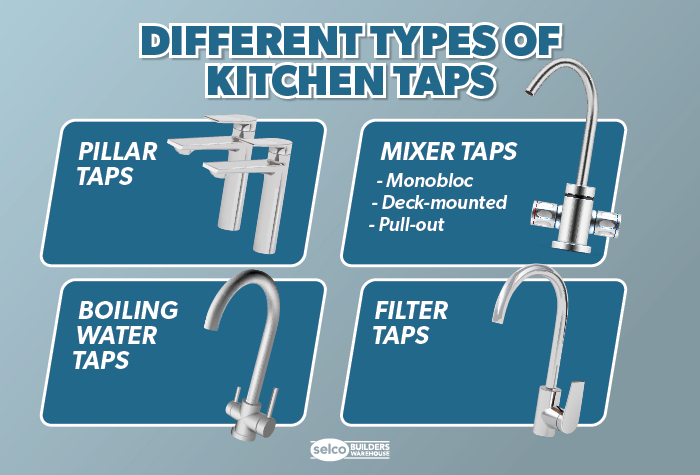
Choosing the right style and finish for your kitchen taps
Once you’ve decided the right type of kitchen tap for your customer, such as a pull-out mixer tap with a water filter or an instant boiling water tap, you can then choose a design that suits your customer’s preferences and style. You’ll also need to consider extras such as tap valve types and tap washer types.
Spouts
Kitchen taps can have various spout styles, including:
- Swan neck spout: A curved spout resembling a swan’s neck that provides an elegant feel.
- L-shaped spout: A more angular spout that creates the shape of an L, perfect for modern homes.
- C-shaped spout: A design popular with pull-out mixer tap, the spout curves downwards into the shape of a C.
- Low spout: Ideal for sinks that don’t have a lot of space available above them.
- Swivel spout: Allows the user to rotate and move the spout from side to side to allow better functionality and reach.
- Straight spout: This simple design has an elongated S-shaped spout that is shorter than other types.
Handles
The handles you’ll use to control the water flow of your taps can have many styles, including:
- Round: Round tap handles have a simple, rounded design that is easy and comfortable to grip.
- Crosshead: Crosshead tap handles have a timeless cross design and are well-suited to traditional style kitchens.
- Lever: Lever handles have long levers that are well known for their superior ease of use.
- Sensor: Kitchen taps with sensor handles can be operated with touch-free technology.
Colours
Whether you’re working in a traditional or contemporary kitchen, there are many colours available for you to choose from for the kitchen taps, including brass for a traditional elegant feel or matt black for a modern, industrial finish, and more:
- Stainless Steel
- Brass
- Nickel
- Satin
- Bronze
- Chrome
- Copper
- Gold
- Rose Gold
- Silver
- White
- Black
Finishes
After choosing their colour, your customer can decide on the overall finish of their tap – would they like their taps to glisten when cleaned or do they prefer a flat matt look? Their choices include:
- Polished
- Brushed
- Matt
How to change kitchen taps
The process of changing kitchen taps will vary depending on the sink and taps style, but the basic steps are:
- Turn the water off in the home.
- Clear everything from below the sink and have a towel and bowl at the ready.
- Disconnect the existing taps from the main water supply.
- Remove the tap along with its flexible hoses.
- Clean all the surfaces/seals where residue from the old taps may be left behind.
- Follow the manufacturer’s instructions of the new tap to mount the tap.
- Connect the new tap to the main water supply.
- Slowly turn the water supply on and check the tap and connections under the sink for leakage.
At Selco, we stock some of the best kitchen tap brands in the UK for you to browse through and find the perfect solution for your customer’s kitchen project.
Get the supplies you need:

By Rae Davis
Rae is a Digital Copywriter within the Selco Team with 10 years' experience in the construction industry and specialises in long-form content writing. With a love for research and simplifying complicated information into easy-to-follow content, she is known for her handy how-to blogs. When she’s not at her desk, she’s got her head either in a book or up in the clouds.
< Back to Kitchens
